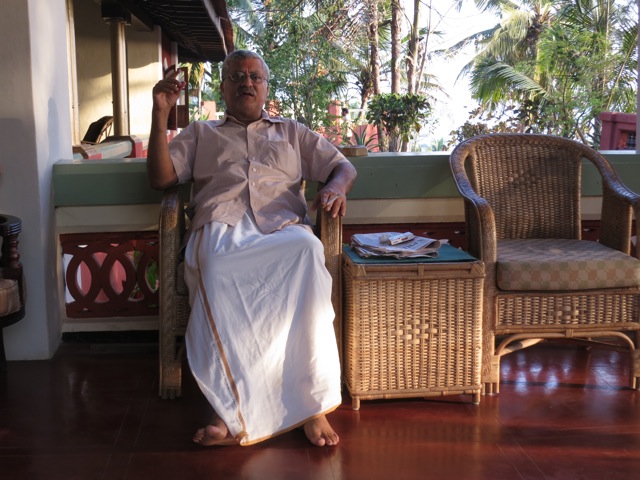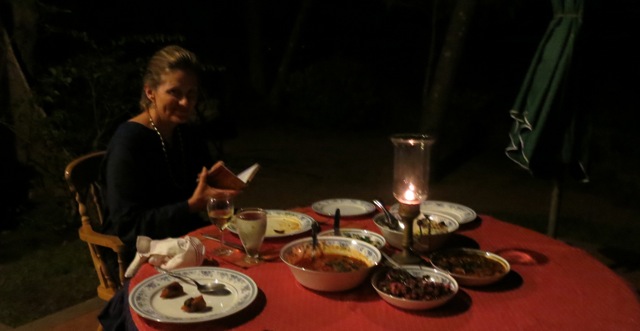Ayesha Manzil, an old Heritage mansion, sits on a hill with a close view of the warm Arabian sea.
It was built by an Englishmen, who was one of the first to set up the East India Trading Office, trading spices from the port of Tellicherry. Pepper, the main sought-after commodity was grown nearby, as well as cinnamon bark and cardamom. These spices along with coffee were stored in the old Portuguese fort until they were ready to be shipped. In those days, the Malabar coast was the epicenter of the spice route, and no other community makes better use of those spices that the Mopillah, the Muslims of North Kerala.
C. P. Moosa’s grandfather took the house over in the 1800s—Moosa has lived there his entire life and, at 60, it seems nothing has changed. Not the furniture, the fans, nor his way of welcoming guests. He pioneered the “home stay” here in India 17 years ago, now especially popular in the south. “There were no good places to stop and eat between Mysore and Cochin,” he says, “so I offered my home.”
As a hotelier, Moosa knew the business of taking care of people and what needed to be done. His wife Faiza, an accomplished cook with passion, also liked the idea of offering cooking classes to weary travelers as a window into the local culture. Together they make fine hosts. Their staff is comprised of a handful of local men who do everything from set the table, do the books, the laundry, and serve tea.
An old white Ambassador was waiting for me at the train station, along with Alan, my escort from the house (Alan Mendoza’s forefathers arrived from Portugal 500 years ago he was proud to tell me, and he still considers himself a certified Portuguese with papers). When we arrived at Ayesha Manzil, Mr. Moosa, barefoot and curious, was there to greet me.
“Hello Peggy. I am Moosa. Come.” He motioned Alan to take my things up the stairs. “Get freshened up. You’ll have dinner, then a good rest, and we’ll be off to the market by 8 am.”
There’s nothing that thrills me more about the hospitality business, rather than chatting with a totally relaxed aristocrat in a lungi [Urdu for “loincloth” or “skirt”]. It makes for a most interesting stay, with me ready to throw off my shoes and street clothes and adorn the same. Lungi’s are the native dress for men, and they all wear them, at least at some point in the day. There are simple ones of checks and patterns, or white with a gold trim for more formal. The sari is traditional for women, with the same informal and formal description. Off white with a gold trim, is the signature look for Kerala. It’s dignified and pure. In the slow south Indian culture and climate, this sort of dress makes total sense, and if the food wasn’t so good, it would be the first reason to be reborn there.

Rosewood beds, teak dressers, wooden floors, all in the neighborhood of 100 to 150 years old. My room was proportionately spacious on the second floor. A big box with a high ceiling, a long desk, and two twin four poster beds with antique mosquito netting that fit over the top and corners and hung down below the mattress edge. Diffused light came from the north facing window in a Dubbusey-like moment, soft on the eyes, falling on the chaise lounge where I loved to lie in a daydream. I could have danced with arms outstretched on the old floor and perhaps no one would have heard me below. Their were no paintings or pictures on the wall. Just practical pieces of furniture and space. I never wanted to leave the room. They had to call me for breakfast…and dinner once, as well.

But leave I did to get into the kitchen with Faiza. Her long Colonial kitchen was simple, but ample with two burners on a narrow stainless steel bench. She gives cooking classes every day and this was Sunday. It should have been a day of rest. She worked with me anyway, knowing that she would have the afternoon to herself. We made tamarind prawns and tamarind eggplant, both with the same base, and the most delicious okra thiyyal. “When you cook with Faiza, your fingers do the motions, you put this and that, but really, you talk about life!” says Moosa.
Indian cooking is not difficult, if you have the ingredients. And like anywhere, it always tastes better where it grows. Getting my hands on the tamarind was a new experience. Soaking it from it’s dry form, it’s necessary to squeeze the pulp twice to get the most out of it. It’s sourness is most pleasant and a necessary flavor in south Indian cooking. I never would have thought to add it to either shrimp or eggplant. But it worked.
Indian recipes are almost always overwhelming with the number of ingredients. Yet, they are quite happy together and even with the complex flavor, you would never know there are so many.

CHEMMEEN VARATTIYATHU
Tamarind Prawns
1 1/2 cup of prawns (as fresh as you can find and cleaned)
2 small red onions, chopped into small cubes
1 small tomato
6-10 fresh curry leaves
2 green chilies, sliced
2 cloves of garlic, chopped
1/2 in piece of fresh ginger, chopped fine
1 1/2 T chili powder (this is where the rubber meets the road)
2 t turmeric powder
2 t coriander powder
a small ball of tamarind (the size of a lime)
1/2 cup of coconut oil
1/2 t mustard seeds
1/2 r fenugreek
salt to taste ( at least 1/2 t)
Clean and wash the prawns. Add 1/4 t termeric, 1/4 t chili powder and a few pinches of salt to the prawns. Make a paste and marinate for 10 minutes.
Heat a Kadai. (Indian wok). Pour 1/4 cup of the oil and bring to a medium heat. Fry the prawns until they start to brown, then set aside.
Heat a sauce pan, pouring in the remaining oil. When the oil is hot, add the mustard seeds until they pop. Then add the fenugreek. When it crackles, add the chopped onions, green chilies, ginger, garlic, curry leaves and sliced tomato until soft. Add the remaining chili powder and turmeric and stir for a few seconds.
Pour in tamarind water, a pinch more salt and simmer for 5 minutes. Add the prawns and a pinch more salt. Simmer on a slow fire until the sauce thickens. Remove from the fire and let sit.
* substitute chunks of eggplant that have been fried separately. Use all ingredients (except fenugreek) and follow the same method.
Dinner for one on a terrace overlooking the dark Arabian sea, the moon is a quarter with a planet above. Auspicious I think. This is a communist state and the moon star and sickle is a statue on the beach. I am the only guest, doted on by a staff of three. Six dishes were put front of me. An appetizer of sardine with a spicy paste grilled on a banana leaf, along with the main meal of aubergine in tamarind, rice with fruits (raisins, grapes and slivered almonds), fried, spiced, okra-flavored yogurt, prawn curry cornmeal stuffing with mussels.
I ate with my hands. I know how to do that now. (The staff was smiling and cheering me on.) Salma Husein taught me in my first days in Delhi, but like anything it takes practice.
I used to think the most common denominator in the world was fire. Now I think it’s eating with one’s hands. Everyone does it. High society, kings, fishermen. All castes. Once you get the hang of it, it’s like…okay…why wouldn’t you want to? It taste so good and feels good too. There is a way and it makes eating with a knife and fork obsolete. I’m even convinced that it’s relaxing and therefore aids digestion. But then again, it depends on what you are eating. Indian food lends itself to the pinching of really tender meat pieces in a gravy, as well as mixing everything with all of your fingers very carefully, then popping it into your mouth. It’s quite an achievement, and comes easy after you stop thinking about it. Totally natural.
“What is this?” said the cook. (A spoon.) “God gave you hands!” Here, you start off feeding babies with your hands. I think now that it is a good trick. There is something transmitted to the child from the mother about the taste and love of food.
Why was I so enthralled with this meal? It was not so different than the other lessons I’ve had. I was attentively savoring and celebrating the flavors of this marvelous cuisine. What could have made this so good?? Then I had a shaktiput experience…I had cooked it myself! Yes. at the loving hands of Faiza Moosa. The first meal I had cooked in over a month. Whether true or not. I did notice something.
The pineapple trifle with ginger tea went down rather well afterwards, and so did the moon.

